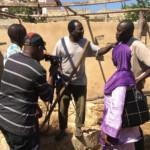
Ulla-Maija Knuutti & Satu Määttänen
21st-century education is increasingly utilising digital tools and online environments. The Covid-19 pandemic during the early 2020s further accelerated this trend with educational institutions worldwide rapidly, and under compulsion, transforming to online teaching and learning.
Digital and online teaching can be used within the classroom or to provide distance learning. In either case, the digitalisation of teaching, if appropriately implemented, offers a wide variety of benefits, such as improved access and outreach, flexibility, and digital skills development. Yet, quality education requires quality teaching methods, such as active learning, i.e. a broad range of techniques, activities and models in which students take an active role in their learning.
In the early 21st century, Africa had the fastest-growing online learning sector worldwide (Adkins, 2013). Yet, the continent faces challenges in digitalising teaching, such as poor (yet constantly evolving) internet connection and a lack of technology and related skills (Moon & Villet, 2016).
In this article, we provide concrete tips and examples – based on our own experiences – on how to overcome the challenges of connectivity, restricted technology, and limited experience and skills in digital teaching. Our focus is on the Sub-Saharan African settings. Yet, the tips presented in this article are utilisable around the world. We acknowledge that converting to digital teaching requires comprehensive and continuing professional development, as emphasised by Moon and Villet (2016). However, the examples in this article can complement professional development or provide a starting point for it.
Everyday devices and tools for digital learning
The educational markets are filled with various digital tools, software and learning environments. However, many of these require a payable license, decent internal memory and data processing capacity, and use lots of internet data. Using this type of software and tools can be difficult, if not impossible, in settings with limited digital resources and data allowances. Indeed, the lack of tools for digital learning is a common reason for not digitalising learning.
To digitalise teaching and learning, one should not focus on what is not accessible, but on the contrary, consider and emphasise what is easily available. What type of devices and tools do almost all students – and teachers alike – use every day? The answer is smartphones and social media. Research and practical applications have demonstrated the feasibility and benefits of using mobile phones and various social media platforms in higher education (e.g. Gikas & Grant, 2013).
Thus, ask students what type of mobile applications, platforms and tools are familiar to them and what they use in their everyday life. These can include, for example, WhatsApp, Facebook, Twitter etc. Then, use these digital tools in teaching. You can try various digital tools and applications with students and collect their feedback. Discard the tools that do not work properly or cause challenges and stick with the ones which are easy to use and liked by students. You do not have to start everything from scratch. To help you – and students – get started, browse literature and the internet, which are filled with various ideas and tips on how to design teaching and learning by using social media and other free-to-use platforms.
Digital learning with a limited internet connection
Many sub-Saharan African countries struggle with unreliable, low coverage and slow internet connection. Not all campuses offer Wi-Fi connections, and students cannot be expected to buy large amounts of costly data bundles for online learning. To enable and encourage active participation, digitalised teaching and learning should be designed to use a small amount of data.
Discard the idea of long, live lecture sessions. Live online meetings usually use lots of internet data, especially if there are many participants. In addition, unreliable connections may cause participants to drop out repeatedly, making it hard to follow up on the topic and discussion.
Instead, prepare short videos of the “lecture” topics, for example, 2-3 videos lasting 5 minutes each. This allows students to watch the videos when they have a proper internet connection and sufficient time. Summarising the theme in concise videos is not the easiest task and requires effort and practice, but it can be highly refreshing to you and the students. To motivate yourself, remember that summarising and being concise are important professional skills for all academics. The videos can be imported to a (free-to-use) software or sent directly to students through WhatsApp or any other messaging service with multimedia options. However, it is important to recognise that if you do not want the videos to be shared outside of the class or want them to be available only for a fixed period, use only streaming options. Downloadable videos can start their “own life” online, as you lose control over them as soon as they are downloaded.
To urge students actually to watch the videos, we recommend providing students with (obligatory) assignments for which they need the information you provided in the videos. Not only do students need to watch the videos to complete the assignments, but this also allows them to keep track of the effort and learning of the students. It is advisable to share various learning materials, such as literature, in addition to the videos. Consider acknowledging and sharing this material and any other guidance in the videos to further compel students to watch them.
The digitalisation of teaching and learning: practical examples
When you have the technical side of digitalised teaching covered, you can dive into pedagogics. Designing and implementing teaching and active learning is not easy, especially in digital settings. To ease the task of designing digitalised teaching and learning, you can start one by one with small exercises, as presented below. This is especially recommended within large classes and in online settings.
- Pair work: Provide a video to students. Divide the students into pairs and provide each pair with a discussion topic. Instruct each pair to summarise their discussion and thinking and either send it to you or share it with the whole class. Define the maximum length of the task, for example, x words or x minutes of a video.
- Formative tests: Throughout the course, arrange formative tests for students through, e.g. free-to-use Google Forms. The tests should be designed for the students themselves to grasp what they have learned and what not, but they also help you keep on track in the learning.
- Demonstrations: Instruct students to give short demonstrations on a given topic in pairs or as small groups. The demonstrations can be as simple as a video recorded by a mobile phone and sent to you or the whole class. These demonstrations are a good way to follow up and evaluate the learning outcomes.
- Peer-teaching: Make students teach each other in student teams. Each team must familiarise themselves with the given topic and share their findings with others through, for example, a video presentation. To activate participants, instruct other teams to comment on the presentations.
- Debates: Arrange team debates by providing opposite statements to student teams. For example, “bioenergy is environmentally friendly”, with one team agreeing and another disagreeing. The teams need to find information to support their claims and provide a short video to present their thinking and justification. The whole class should watch the videos and discuss which points were convincing, which were not and why.
- Experience: By using the steps described above, familiarise yourself and the students with active learning methods and with the digital learning tasks. With more experience, you and your students will get closer and closer to the deep end of active learning and digitalised teaching.
Authors
Ulla-Maija Knuutti, M.Sc. in Rural Development from Häme University of Applied Sciences. She works as a Senior Lecturer at HAMK Edu Research Unit.
Satu Määttänen, M.Sc. in Agricultural Sciences and M.Sc. in Environmental Science and Policy from the University of Helsinki. She works as a Research Assistant at HAMK Bio Research Unit.
References
Adkins, S. S. (2013). The Africa Market for Self-paced eLearning Products and Services: 2011-2016 Forecast and Analysis. Ambient Insight Regional Report. https://www.yumpu.com/en/document/view/28316609/the-africa-market-for-self-paced-elearning-ambient-insight
Gikas, J., & Grant, M. M. (2013). Mobile computing devices in higher education: Student perspectives on learning with cellphones, smartphones & social media. The Internet and Higher Education, 19, 18–26. https://doi.org/10.1016/j.iheduc.2013.06.002
Moon, B., & Villet, C. (2016). Digital Learning: Reforming Teacher Education to Promote Access, Equity and Quality in Sub-Saharan Africa. Commonwealth of Learning (COL). http://hdl.handle.net/11599/2443





